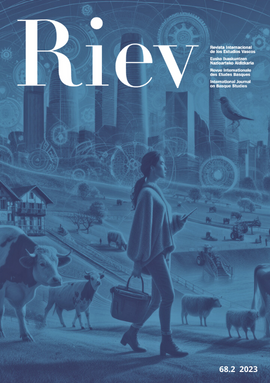Lan honek bi ikuspegi soziotekniko aztertzen ditu teknologia digitalak erabiltzen dituzten komunitate adimendunak egiteko, makinen eta pertsonen arteko elkarrekiko ikaskuntza ahalbidetuko duen lankidetza handiagoa lortzeko. Alde batetik, koprodukzioak jokabide-aldaketa sustatzen du, herritarrak kodiseinuko eta baterako diseinuko prozesuan ahaldunduz, erabiltzailean oinarritutako irtenbideak diseinatuz, tokiko ezagutza aprobetxatuz, lankidetza sustatuz eta gaitasunen garapena erraztuz. Bestalde, herritarren zientziak jokabide-aldaketa eragin eta ahalbidetu dezake, komunitatearentzako ekintza jasangarriagoak, arduratsuagoak eta orientatuagoak egiteko, kontzientziazioa, komunitatearen gaikuntza eta lankidetza sustatuz. Lan honen arabera, bi ikuspegi horiek lagun diezagukete aurrera egiten, gizakiak beti begiztan sartuko dituen informatika-belaunaldi berri baterantz, hau da, informatika humanizaturantz.
Humanized Computing for higher collaboration and reciprocal learning between machines and people
Humanized Computing for higher collaboration and reciprocal learning between machines and people
1. Introduction
Large Techno Social Systems (LTSS)[1] involve leveraging technological advancements and digital platforms to improve access to essential services, enhance quality of life, and ensure social inclusivity. In LTSS, people are not mere users of networked technologies and services designed for optimization purposes. Their behaviour becomes one of the key levers for designing technologies turning them into what might be referred as “Smarter people” that teach their surrounding environment (and embedded devices) but learn reciprocally from it (them).
Indeed, LTSS may be realized by promoting smart communities, i.e. groups of related people which leverage technology, data, and innovation to improve the quality of life for its residents, enhance sustainability, and optimize the use of resources. Human-centric technology can empower citizens to actively engage in societal decision-making processes, participate in democratic systems, and contribute to societal welfare. For instance, participatory budgeting is a democratic process in which community members directly decide how to spend part of a public budget, which can be greatly enhanced using human-centric technology platforms. On the other hand, technological advancements, including data analytics and Artificial Intelligence (AI), can inform evidence-based policymaking and planning processes. For example, in a Health Monitoring and Intervention Program, wearable devices collect health data from individuals, including physical activity, heart rate, sleep patterns, and glucose levels and AI algorithms process the collected data to identify individuals at high risk of developing AI algorithms process the collected data to identify individuals at high risk of developing Non-Communicable Disease (NCDs). Thus, digital technologies have the potential to influence human behaviour change by providing information, personalized feedback, social support, targeted interventions, and opportunities for learning.
This paper analyses how LTSS can benefit from two emerging socio-technical research fields which combine digital technology and societal innovation and transformation, namely co-production[2] of public services and Citizen Science (CS)[3]. On one hand, co-production of public services is a collaborative process[4] between service providers (such as government agencies or non-profit organizations) and service users (such as citizens, patients, or clients) to design, deliver, and evaluate public services, e.g., a mobile app to allow citizens co-design and co-decide urban transformations – such as introduction of cycling paths – in a city. This approach recognizes that service users have valuable knowledge and expertise that can help to improve the effectiveness and efficiency of public services[5]. On the other hand, Citizen Science is a term used to describe the involvement of both professional and non-professional individuals (Citizen Science) in scientific research projects. CS can take many forms, from crowdsourcing data collection and analysis to participatory experiments and community-driven research initiatives. The involvement of citizen scientists in research projects can help to expand the reach of scientific inquiry, increase public understanding of science, and promote scientific literacy and engagement. For instance, CS can be used in Air Quality Monitoring and Policy Development, where new targeted and effective policies are developed based on the aggregation and analysis of comprehensive, real-time data crowdsourced by wearable sensors carried by citizens at diverse temporal and geographic locations.
In essence, co-production, and CS, which is itself a realization of co-production for policy design and verification purposes, favour the formation of communities of practice[6] in which the individuals and relevant stakeholders who share a common concern, passion, or interest in a topic get regularly together to fulfil both individual and group-based goals[7].
The structure of the paper is as follows. Chapter 2 discusses and correlates some concepts and earlier works on how smart technology enables smart communities where people and machines cooperate to achieve reciprocal learning. Chapter 3 exemplifies how LTSS can be achieved by means of co-production where multi-stakeholders’ smart communities collaborate to deliver new more widely adopted public services. Chapter 4 exemplifies how LTSS aided by CS can help make smart communities influencing and verifying public policies. Chapter 5 concludes the paper by drawing some conclusions and suggesting some further work.
2. Reciprocal learning and behaviour change as levers of Smart Communities
Reciprocal learning[8] in the context of human-machine interaction refers to a system where both humans and machines learn and adapt based on their interactions with each other. It signifies a symbiotic relationship in which both entities benefit from the insights and knowledge of the other. Some fields where reciprocal learning (see Figure 1) may be applicable are:
- Adaptive Learning Algorithms, where on the Human to Machine side, machines learn from human feedback, behaviours, and preferences to optimize their performance or functionalities, whilst on Machine to Human side, humans learn to adapt or modify their behaviours or approaches based on machine-generated data or insights.
- Cognitive Augmentation, where on the Human to Machine side, humans utilize machines to augment their cognitive capacities, such as memory, decision-making, so on, whilst on the Machine to Human side, machines learn to better augment human cognition by understanding individual patterns, behaviours, and preferences.
- Personalization, where humans obtain personalized experiences in various domains such as education, healthcare, so on, based on individual preferences and needs, whilst machines can develop more personalized and user-centric systems and applications.
Figure. 1. Reciprocal learning as a combination of cognitive augmentation, adaptive learning, and
personalization, where humans and machines exchange knowledge and learn from each other.
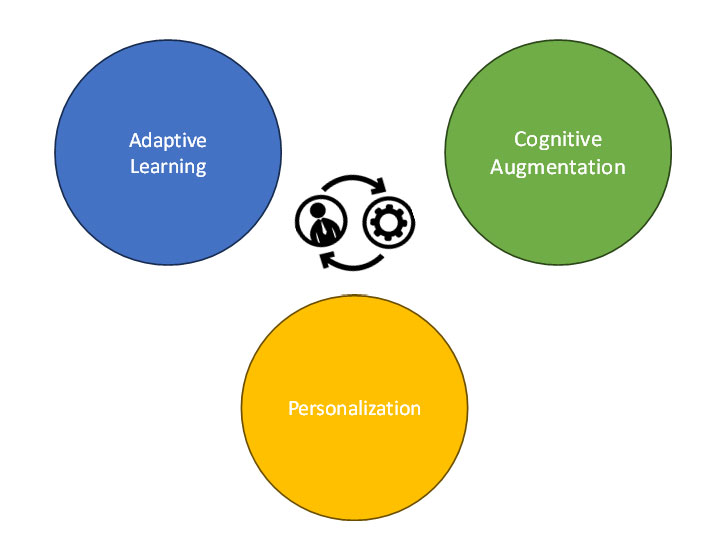
Hence, reciprocal learning between humans and machines clearly brings about the potential to drive significant advancements in AI and benefit society[9] in various ways but is also raises several challenges that need to be addressed:
- Data Privacy and Security: Ensuring the privacy and security of user data in reciprocal learning systems.
- Bias and Fairness: Addressing potential biases in machine learning algorithms and ensuring fairness in AI systems.
- Ethical Dilemmas: Navigating the ethical dilemmas associated with the integration of AI into various aspects of human life.
Anyhow, reciprocal learning between humans and machines can be a fundamental aspect in the development of smart communities[10]. These communities harness the latest advancements in technology, including AI and IoT, among others, to improve the quality of life, optimize resources, and foster a sense of community. Some stereotypical examples of smart communities are:
- Traffic and Transportation, where on the Human to Machine side, residents may provide feedback on traffic patterns, road conditions, and public transportation services, whilst on the Machine to Human, AI systems analyse such data to optimize traffic flow, reduce congestion, and provide real-time updates on transportation services.
- Community Engagement, where on the Human to Machine, citizens participate in community decision-making processes through digital platforms, whilst on the Machine to Human side, AI systems analyse data to facilitate more inclusive and effective community driven decision making.
Smart communities take part in reciprocal learning through surrounding ubiquitous emerging smart devices and services such as:
- Health and Fitness Trackers: Wearables such as the Fitbit or Apple Watch monitor physical activity, sleep patterns, heart rate, so on. By providing data and insights, these devices can motivate individuals to adopt healthier lifestyles, exercise more, and get better sleep.
- Environmental Awareness Tools: Smart thermostats like Nest can optimize energy use in homes. When people see how much energy they are saving (or wasting), they might be more inclined to adopt energy-efficient behaviours.
- Community Building: Platforms that foster communities around positive behaviour (like exercise forums or reading groups) can provide the social motivation and support needed for individuals to change and maintain positive habits.
- Augmented Reality (AR): AR can overlay useful information on the real world. For example, an AR app might provide historical or cultural information when a user looks at a monument, encouraging continuous learning.
Undoubtedly, smart technical solutions can serve as the foundation for building smart communities and influence their behaviour change[11] by providing information, personalized feedback, social support, targeted interventions, and opportunities for remote learning. In fact, by leveraging the capabilities of increasable ubiquitous smart devices and services, individuals can be empowered to adopt and sustain positive behaviours that align with their goals and aspirations. Some manifestations on how digital technology fosters more informed, aware, and intellectually agile populations, are:
- Instant Access to Information: With the internet and mobile devices, vast amounts of information are at our fingertips. When someone has a question, they can easily search for answers, enhancing general knowledge.
- Educational Platforms: E-learning platforms such as Coursera, Udemy, and Khan Academy have democratized education. People across the world can now access courses on various subjects, often for free or at a low cost.
- Artificial Intelligence (AI) Assistants: Virtual assistants such as Siri, Alexa, and Google Assistant can answer questions, set reminders, and even provide briefings on certain topics, thus facilitating more informed lifestyles.
- Analytics and Data Visualization: With the rise of big data, individuals and organizations have tools at their disposal to visualize and interpret vast amounts of information, leading to higher awareness and better decision-making.
Consequently, smart human-driven technology, when designed and implemented thoughtfully, has the potential to induce positive behavioural changes in people. However, it is worth noting that while technology offers myriad tools for enhancement[12], it is the responsibility of individuals and societies to use them judiciously. Over-reliance on technology can lead to issues such as the spread of misinformation, reduced attention spans, and a lack of critical thinking. Thus, a balanced approach, combining the best of tech with traditional learning and critical thinking methods, can truly lead to smarter and more aware populations. Indeed, combining technology with conscious decision-making and self-awareness is crucial to achieving genuinely positive behaviour change[13]. Otherwise, over reliance on technology can also lead to alienation among individuals, e.g. reduced face-to-face social interactions, loss of traditional skills, and even fostering feelings of inadequacy or stress in keeping up with the latest tech trends.
The ethical and societal implications of technological advancements, particularly in the realms of privacy, data ethics, and the impact on labour markets, are increasingly crucial. Works like[14] and[15] highlight the risks of data misuse, potential privacy violations, and the commodification of personal information in the age of big data and AI. Concurrently, the transformation of the workforce due to AI and automation, as discussed in[16], raises concerns about job displacement and the need for educational and policy reforms. The book[17] adds to this discourse by examining the ethical challenges in AI decision-making, emphasizing the necessity of aligning AI systems with human values. These works collectively call for a balanced approach to technological development, prioritizing ethical responsibility alongside innovation.
3. Smart Communities for Multi-stakeholder Engagement and Participation
Following the four-helix paradigm[18], smart technology can empower citizens and other stakeholders (public servants, private companies’ employees, and academics), to actively engage them in decision-making processes, participate in democratic systems, and contribute to societal welfare. Online platforms may be used to facilitate community-driven initiatives, crowdsource ideas for social change, and enable collaboration between citizens, organizations, academia, and government institutions.
As earlier introduced, co-production of public services[19] refers to the collaborative and participatory process in which service providers and consumers work together to design, deliver, and evaluate services and initiatives. Co-production in the context of smart communities promotes behaviour change by empowering citizens, designing user-centric solutions, leveraging local knowledge, fostering collaboration, and facilitating capacity building.
Collaborative platforms[20] can aid in co-production, i.e. co-design and co-delivery efforts, by providing communication tools like messaging systems, discussion forums, and video conferencing that allow stakeholders to communicate and establish a shared understanding of the problem, establish goals, and resolve conflicts. Research has shown that for collaborative initiatives to be effectively supported digitally, key factors include coordination, continued engagement, access to open data, and shared information[21]. Some widely used tools in this regard are: Miro[22] – a virtual whiteboard platform that enables collaborative brainstorming and diagramming; Trello[23] – an online project management tool to manage and track the progress of co-production projects; or Notion.so[24] – communication and collaboration tool for virtual collaboration, file sharing, and task management between service providers and service users. However, the flexibility and freedom of use of these tools come at the expense of guidance of the underlying co-production processes. What is missing is an explicit operationalization of the whole co-production process, considering the specificities of the type of service to co-deliver.
The INTERLINK H2020 project[25] aims to overcome the barriers that hinder administrations to reuse and share services with private partners (including citizens) by combining the advantages of two often opposed approaches:
- “top-down” approach where Government holds primary responsibility for creating these services compliant with EU directives, sometimes seeking the support of citizens for specific design or delivery tasks.
- “bottom-up” approach in which citizens self-organize and deliver grassroot services where government plays no active role in day-to-day activities but may provide a facilitating framework.
INTERLINK is a 3-year project which started in January 2021 and that has produced as main contribution a Collaborative Environment (CE) which supports the holistic management of co-production processes for new or updated public services.
For that, INTERLINK defines a four sub-phase co-production process (see Figure. 2) to be followed by distinct co-producers (see Figure. 3) of generic public services, but that can be customized to the co-production challenge on stake. Notice that these 4 sub-phases are grouped into two main phases, namely:
- Co-design phase. It concerns activities that incorporate “the experience of users and their communities” into the creation, planning, or arrangements of public services. In it, the co-production team is created and starts working together to define the service to be co-produced. This phase entails two sub-phases: Engagement and Design. See Figure. 2 for more details about the scope of each co-production sub-phase.
- Co-delivery phase. It is a joint effort by public authorities and stakeholders to provide and improve public services, where the service is implemented and delivered in a sustainable manner. The co-delivery phase entails two sub-phases: Build and Sustain. Note that the sustain sub-phase is added to ensure that for every co-produced artefact, there is a sustainability plan to foster its exploitation or reuse after it has been delivered.
Figure. 2. Generic co-production model in INTERLINK
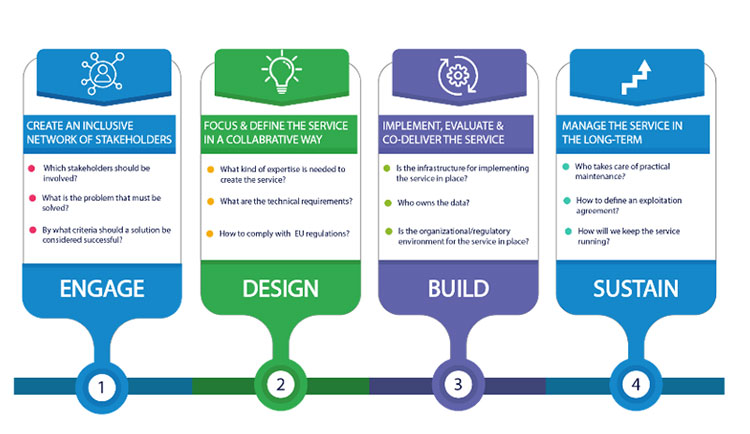
Figure. 3. Public Service co-production stakeholders (co-producers)
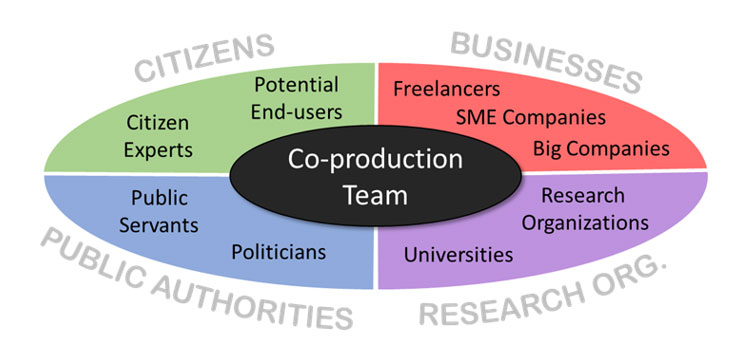
INTERLINK’s main contribution is a supportive collaborative digital environment specifically designed to operationalize and democratize co-production of public services among multiple stakeholders assembling a smart community.
3.1. INTERLINK’s Collaborative Environment
The INTERLINK’s Collaborative Environments (CE)[26] is designed to support INTERLINK’s co-production methodology and facilitate its adoption for co-production of novel collaborative processes and services. The design principles of such a digital environment have been:
- Promotion of collaboration and reuse. The INTERLINK platform offers a digital environment that facilitates co-production processes between Public Administrations, private stakeholders and citizens and promotes the re-use of software and knowledge assets for delivery of public services.
- Holistic support of the co-design and co-delivery phases of co-production. INTERLINK provides a step-by-step guidance, tracking and valorisation for the co-design and co-delivery of public services along with guidelines, tips and templates that facilitate the collaboration of different actors.
More concretely, this CE offers the following core functionalities: a) co-producer team and process management; b) guide for co-production process by means of schemas of steps to follow; c) recommendation of knowledge and software co-production enablers (called INTERLINKERs) most suitable to the problem domain represented by the chosen co-production task; d) selection, instantiation, assignment, claim and registry of use of INTERLINKERs (e.g. a CS campaign specification template) and e) INTERLINKER catalogue to browse, search and review publicly available co-production enablers and processes.
An assortment of co-production INTERLINKERs has been created to provide functionality useful in generic co-production contexts, e.g.: a) interlinker-googledrive to deal with office documents, b) interlinker-survey to design and host answers for surveys; or c) webpage augmenter to annotate web pages. All those software enablers exhibit a common API to ease integration, previously reported in[27]. On the other hand, several knowledge INTERLINKERs have been defined, e.g., Stakeholder Mapping Canvas, Use Case Scenarios or Business Model Canvas templates, created declaratively by means of a JSON schema. Likewise, co-production process schemas can be declared in JSON which are tuned to the specifics of a co-production process type, e.g., a Hackathon organization schema or a Citizen Science (CS) campaign execution schema (see Figure. 4), which has been used in SOCIO-BEE[28] project, further described in section 4.
Figure. 4. Co-production process for Citizen Science campaign execution, where DESIGN phase
objectives and tasks are shown, together with resource instantiate for selected task.
Notice actions that can be performed over a resource
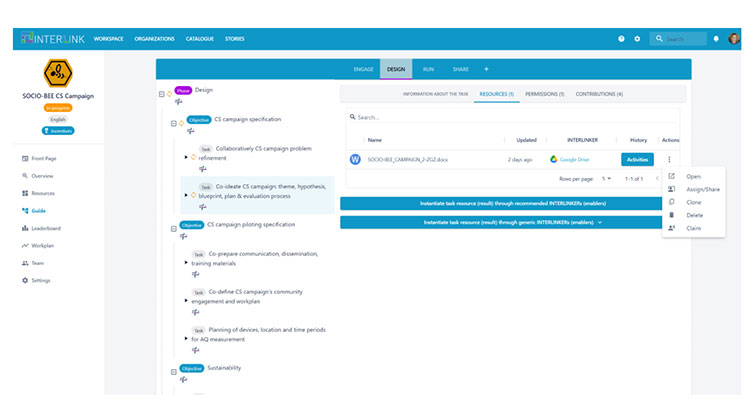
Notice in Figure. 4 how the generic BUILD sub-phase (at the top) provided by default by INTERLINK’s co-production processes is replaced in the custom citizen science co-production tree/schema shown by a RUN sub-phase, with hackathon execution specific composing objectives and tasks. Importantly, the CE enables co-production processes to be customized (adding, modifying, and removing phases, objectives, and phases to a process) by clicking on the “+” sign present at the right-hand side of the last phase name. These features set our CE apart from other collaborative tools. Besides, our CE can be extended with additional tools and templates, thereby making feasible the incorporation of new enablers for a given problem domain, e.g., data protocol guideline for Citizen Science’s campaigns co-production. By following a microservice approach and integrating through APIs, third-party open-source software components can be easily integrated into the platform. This flexibility empowers users to create new types of enablers and enhance the overall functionality. For instance, as result of our work in SOCIO-BEE project, a micro-volunteering engine tool[29] for orchestrating among a group of citizens crowdsourcing of data has been provided, which is useful in the CS campaigns co-execution.
3.2. Tackling co-delivery: replication and sustainability
Traditionally co-production processes tackle the CO-DESIGN part of co-production and neglect the CO-DELIVERY part, which is the one fostering replication and sustainability. As a matter of fact, as a reflection of INTERLINK project’s iteration 1’s piloting, the need to reinforce replicability was made clear, i.e., it should be able to share success stories and to use them to bootstrap new processes. Besides, the need to reinforce sustainability was evident, i.e., co-production supporting solutions must portray progress in co-production processes and acknowledge team member contributions, otherwise long-term commitment of collaborators is not feasible. Hence, the following features were incorporated into the Collaborative Environment. Firstly, to promote replicability:
- Process cloning – so that a new co-production process can be created based on an existing one. Only valid for a co-production team’s own processes, it is useful for teams that want to reuse processes where they participated previously.
- Cloning from success story – the CE includes the ability to publish a co-production process in the form of a success story (see Figure 5), allowing anyone to clone it. This is interesting to allow third parties, i.e., other teams of co-producers, to benefit from the co-production efforts of other teams for envisaged artefacts/results of similar nature.
Figure 5. Success stories from which new processes can be cloned
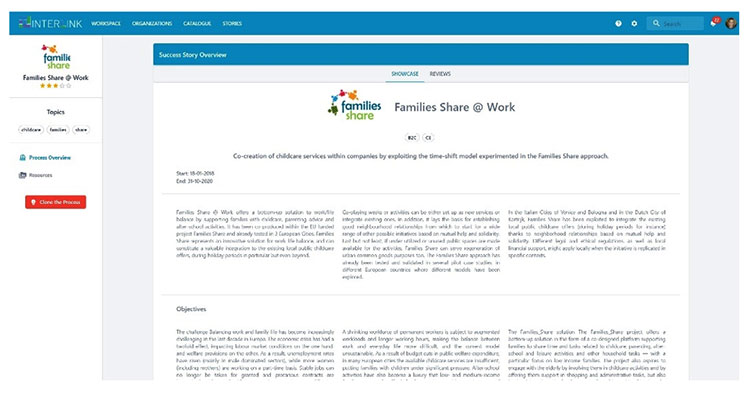
Figure 6. Contributions pane of task view showing activities carried out by a user
over the task and how that person can claim the work carried out by him
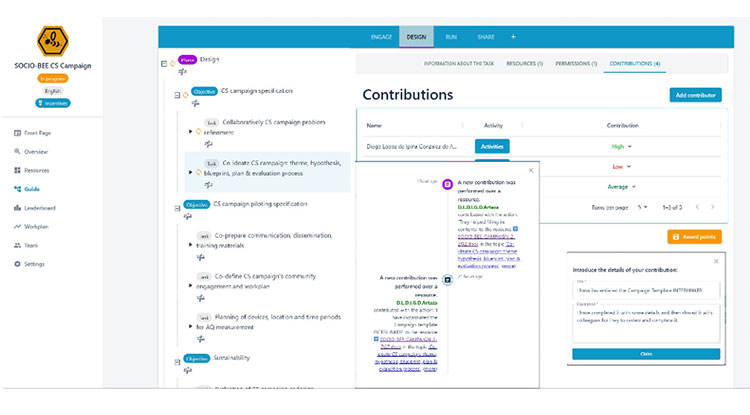
To support sustainability, the CE has been integrated with a Gamification Engine[30]. The idea is to be able to account what each member of the team contributes with and, hence, acknowledge the contribution of each team member in the whole co-production process and its composing tasks, by providing a board of points. For this integration, the following additional functionalities have been added:
- Activity timeline – the Collaborative Environment has been extended to allow a process admins to review what the team has done over a process or what everyone has contributed with for the whole process or a single task (see Figure 6’s activities timeline popup).
- Contribution assignment, claim and validation – team members can now be assigned work in resources and as result claim what they have done over the resources of a tasks (see Figure. 4’s right hand side popup pane showing options “Assign/Share” and “Claim”). On the other hand, process admins may validate the team members contributions (see Figure 6’s Contribution pane’s table – on the bottom right-hand side – showing contribution level of each participant in a task and “Award points” button). Thus, the CE calculates the contribution quota of a user in each task based on the configured complexity of the task and the level of contribution of the user in that task versus total contributions in task. Once a given task contributions are validated, it is closed, and point calculations realized. A central leader board showcases (see Figure 7) the contributions, valued as points for the different team members.
Figure 7. Leaderboard showing scores of contributors to a SOCIO-BEE’s coproduction process
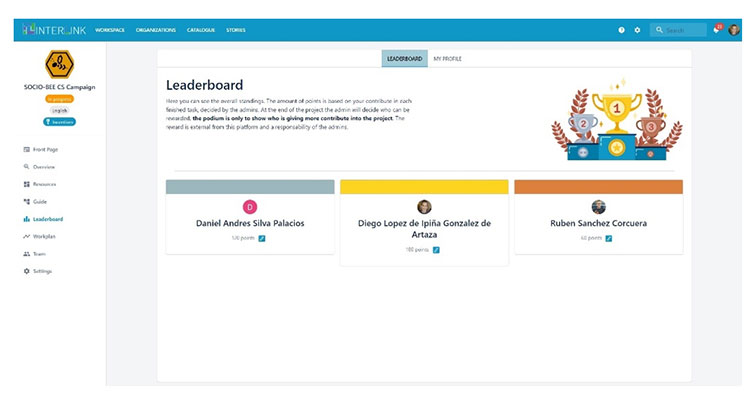
3.3. Assessing the impact of co-production of public services
The Collaborative Environment’s capability to support co-production and deliver more widely adopted co-produced services has been evaluated in three pilots across Europe. Firstly, in the Ministry of Economy and Finance - Italy (MEF) – a mock-up of a Participatory Strategic Planning Module (called PSPM) was produced which allows Public Bodies and their staff to actively participate in the definition of the Strategic Plans, as well as to have access to a repository of good practices on strategic planning approaches and methodologies. Secondly, at VARAM, the Ministry of Environmental Protection and Regional Development of the Republic of Latvia and its Latvian State Portal, which is a portal that provides easy access to services delivered by state and local government institutions. The goal was to continuously update and enhance such portal descriptions so that the public services published are increasingly adopted. Thirdly, at Zaragoza city (ZGZ) and its Center for Art and Technology (eTOPIA), where the aim was promoting collaborative city-making facilities and programs and improving the process of Open Innovation.
Our evaluation hypothesis in pilots’ iteration 1 was that the perceived adoption, may be driven, on one hand, from Usability, User Experience and Effectiveness, and, on the other hand, from the Trust and Acceptability brought forward by our co-production environment. To be able to measure and compare these evaluation constructs or dimensions, we carried out a longitudinal study where technical tests, logs and questionnaires customized to different stakeholders have been used to determine the quality associated with the INTERLINK co-production model and its resulting artefacts. Some exemplary qualitative measurement mechanisms used were: thinking aloud evaluations, cross-testing sessions and interviews with end users. On the other hand, the following quantitative measures were adopted: a) Surveys and questionnaires to explore usability, trust, and acceptance, and, hence, deduce the adoption of INTERLINK proposed co-production process and artefacts; and b) Data logs collected both from the collaborative environment and INTERLINK powered public services’ data models to allow for the analysis of user interactions with those tools and services.
As a result, we have quantified the associated quality of the co-production support provided by our CE. For that the following formula has been applied:
QoS co-production = average(user-based quality; value-based quality; satisfaction; trust; acceptance).
where:
User-based quality = average (Effectiveness, Efficiency, Usefulness, Ease of Use, Flexibility).
Value-based quality = average (Inclusiveness, Security/Privacy, Democratic values, Weberian criteria).
User-based quality means that the attributes of a product meet the customer’s requirements (in the public sector this is very important due to the need for public accountability). The “quality in use” model is composed of five characteristics that relate to the outcome of interaction when a product, process or service is used in a particular context of use. These characteristics are:
- Effectiveness: accuracy and completeness with which users achieve specified goals.
- Efficiency: resources expended in relation to the accuracy and completeness with which users achieve goals.
- Usefulness: extent to which a product, service, or system meets the needs and requirements of its users.
- Ease of use: refers to how user-friendly, accessible, and intuitive a product, service, or system is for its intended users.
- Flexibility: refers to the adaptability and versatility of a product, service, or system to meet the diverse and changing needs of its users.
Value-based quality refers to an understanding of quality as processes/outcomes being in line with normative expectations towards public services (e.g. legal treatment) and broader societal norms (e.g. democratic values). These characteristics are defined as:
- Inclusiveness refers to citizens’ perception that the e-government system increases the accessibility of public services and makes service delivery more egalitarian.
- Security/privacy of the data processed, managed and stored by an e-government solution.
- Democracy: citizens’ perception that e-government systems empower the public.
- Public service relevant Weberian principles: a) Impartiality/Neutrality; b) Rule-boundedness; c) Scribability (existence of “files”) and d) Professionalism.
On the other hand, there are three interlinked dimensions that ground into each other in order to measure adoption:
- Satisfaction: degree to which user needs are satisfied when a product or system is used in a specified context of use.
- Trust is defined as the belief that a public body will contribute to people’s wellbeing through their interaction or actions. In this case, by means of the provision of a co-production model, supporting tools for co-production and co-produced artefacts.
- Acceptance whilst acceptability refers to one’s perception of a system before use, acceptance is one’s perception of the system after use.
The values for each evaluation dimension were calculated automatically by a set of Python scripts that explored the answers gathered at the evaluation questionnaires passed to participants in the three indicated pilots and performed queries over the data model of INTERLINK. Table 1 shows the perceptions of co-producers (a total of 53 people) of public services and end-users of co-produced artefacts. As shown in the table, the obtained QoS values per pilot are very encouraging, although not conclusive, offering an overall 3.79/5,0 (among co-producers) score in a 1-5 Likert scale. Besides, a moderate acceptance level perception, 3.24/5 (among co-producers) was achieved. INTERLINK is currently undergoing its second evaluation where results should be improved, since we have integrated in the environment the feedback received from iteration 1.
Table 1. Evaluation results of INTERLINK’s pilots’ iteration 1
.png)
4. Smart Communities for Data-Driven Policy and Planning through Citizen Science
Technological advancements, IoT, data analytics and artificial intelligence, can inform evidence-based policymaking and planning processes[31]. By analysing large volumes of data, policymakers can gain insights into societal needs, identify gaps in social welfare systems, and design targeted interventions.
Notably, CS is increasingly recognized as a valuable tool for monitoring and mitigating the effects of climate change in our cities[32]. For instance, CS campaigns can provide data that complements traditional air quality monitoring methods, help to identify pollution hotspots, and engage local communities in efforts to improve air quality. Additionally, CS can help to raise awareness about the impacts of climate change, e.g. air pollution, on public health and the environment and promote public engagement and action on this critical issue.
The EU project SOCIO-BEE[33] aims to design, deploy, and validate a next-generation CS platform which orchestrates citizens carrying wearable devices for air quality observation and, at the same time, supports local decision-makers and action groups. It aims to realize sustainable, scalable, and replicable/spreadable experiments, which are co-created. As a matter of fact, SOCIO-BEE makes use of INTERLINK’s CE for CS campaign co-creation for this purpose. Through it, users can select among several customizable campaigning blueprints each of which benefit from SOCIO-BEE platform’s tools for delivering engagement programmes and campaigns that genuinely enable communities to influence decision-making for reducing pollution levels in cities and creating trust between stakeholders. In essence, it explores the facilitation of structures to increase citizen engagement and awareness of climate change through experimentation and monitoring of the environment.
SOCIO-BEE platform is being piloted in 3 piloting cities across Europe (Ancona – IT with focus on elderly people, Maroussi – GR with focus on commuters, Zaragoza – ES with focus on secondary education students). The project aims to tackle the challenge of “Collecting high-resolution air quality data through opportunistic sensing ensuring replicability”. The eventual outcome of the project is expected to be turning “citizens, policymakers, voluntary sector and businesses as stewards of air pollution reduction policies”.
Air quality[34] is a critical environmental factor that refers to the presence of various gases and particles in the atmosphere that can pose risks to human health and the environment. Air quality management involves monitoring air quality, identifying sources of pollution, and implementing measures to reduce emissions. These measures may include promoting clean energy technologies, reducing traffic congestion, and promoting public awareness and education. Working to improve air quality can help to protect public health and the environment for future generations.
The following sub-sections, firstly, describe the “bee metaphor” proposed by the project, which is our adoption and adaptation of the “community of practice” concept, secondly, provide details about the platform devised to support the mobilization of communities of practice through CS experimentation to increase the awareness and knowledge to tackle air pollution and, thirdly, report on the progress achieved in the piloting of the project.
4.1. The BeeHive metaphor: stakeholder and methodology
Through an example taken from nature, SOCIO-BEE builds on the metaphor of bee colonies to develop effective behavioural and engagement strategies with a wide range of stakeholders, namely, Beekeeper, Queen Bees, Drone Bees, Working Bees, and Bears, and to co-create through Citizen Hives long-lasting solutions against urban air pollution supported by emerging new technologies such as drones or wearables.
Figure 8 shows the roles that different members of a hive may play within SOCIO-BEE and what functionalities the underlying SOCIO-BEE platform offers them to manage and partake in CS campaigns:
- Beekeeper: S/he is responsible to set up a new hive. S/he adds members to that hive. S/he creates a new campaign based on SOCIO-BEE toolkit element for on boarding and engagement, i.e., campaign template.
- Queen Bee: S/he firstly configures CS campaigns (area, measurements’ type, frequency and period, research questions to address and so on). Secondly, it launches, manages, and monitors the evolution of the campaign and measurements being taken by fellow Worker Bees. S/he also takes part in interim publication of results for the hive and its stakeholders. Finally, s/he closes the campaign and pushes wide dissemination and communication of its results, reflecting in workshops with other hive stakeholders, namely, bear, beekeeper, and hive members.
- Worker Bees: they are notified about new campaigns where they can partake. Through a mobile app and a wearable AQ sensing device, whenever they have time they get recommended possible cells to pollinize. They recurrently gather new measurements during a campaign’s timespan. They can also capture audio/video, whilst 90’’ long air quality measurements are taken with the AQ wearable devices. They regularly check how the pollination in the campaign is ongoing and access heat maps informing about air quality evolution in space and time. They are informed about the end of campaigns and provide feedback of their experience through mobile app. They take part in post-pilot reflection workshop.
- Drone Bees: they receive generic information about the AQ CS campaigns arranged by a council. They spread the results of campaigns published in easily graspable manner to enhance understanding of the effects of air pollution and remediation actions. They are invited to attend to reflection workshops to have a say regarding possible actions to be taken by the public administration.
Figure 8. Bee metaphor employed by SOCIO-BEE
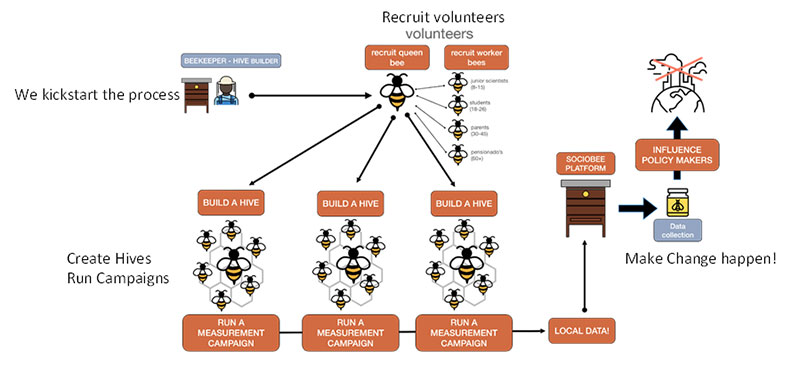
4.2. The SOCIO-BEE platform
The SOCIO-BEE integrated platform has been designed to facilitate the strategic planning, efficient management, effective execution, and comprehensive evaluation of Citizen Science (CS) campaigns. This platform is comprised of four major components, along with several internal sub-components:
- AcadeMe is the main component of the system. It contains the User Interface (mobile and web app) that the end users use. It is responsible for the user management and the creation of the AQ analytics. For this reason, it contains several internal sub-components such as the data parsing, the gaps identification and anomaly detection, the prediction and visualization engines, or the hypothesis and training material handlers.
- Micro-Volunteering Engine (MVE) microservice is responsible for managing campaigns hosted at the SOCIO-BEE platform. The main contribution of this component is to issue recommendations to the end users about the most plausible locations that need to be measured regarding air quality.
- BEE-MATE microservice is another complementary component of the SOCIO-BEE platform that may be used for capturing and analysing multimedia data, in the location where AQ measurements are taken, to extract information about the air quality and the source of pollution in that specific context.
- Wearable Sensor Nodes are the physical device (see Figure 9) used to collect pollution data and this component will work in close communication with the AcadeMe mobile app to acquire and propagate the collected data.
Figure 9. SOCIO-BEE’s Air Quality (AQ) measuring wearables
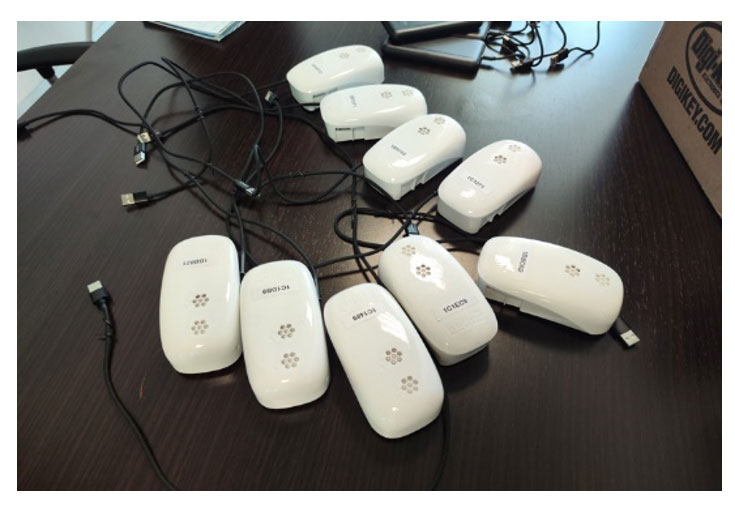
The SOCIO-BEE platform handles the following conceptual entities to make running CS campaigns feasible:
- Members of the SOCIO-BEE community who join Hives in different roles.
- Hives which are teams of different role members who are willing to participate in campaigns.
- Campaigns which allow a hive to realize a Citizen Science experiment with a specific purpose (hypothesis to validate).
- Campaign blueprints that define the strategy and analysis methods under which the campaign will be executed.
- Devices in the form of wearables, drones or physical devices that allow AQ measurements to be taken.
- Measurements taken either from wearable devices of users or from fixed sensors allocated in the area assigned to a campaign.
- Data analysis pipelines configured to deliver visualizations and insights.
- Decision support tools in the form of visualizations or calculation of KPIs, useful for fellow citizens and promoters of a campaign to understand better effects and mitigation mechanisms for Air Quality.
- Toolkit elements available to support assembly of hives and momentum holding to organize, execute and reflect about campaigns execution.
- Training and communication materials to enhance awareness and learning about AQ.
Figure 10. SOCIO-BEE’s technology supported process for a) Beekeepers, b) Queen bees and c) Worker bees
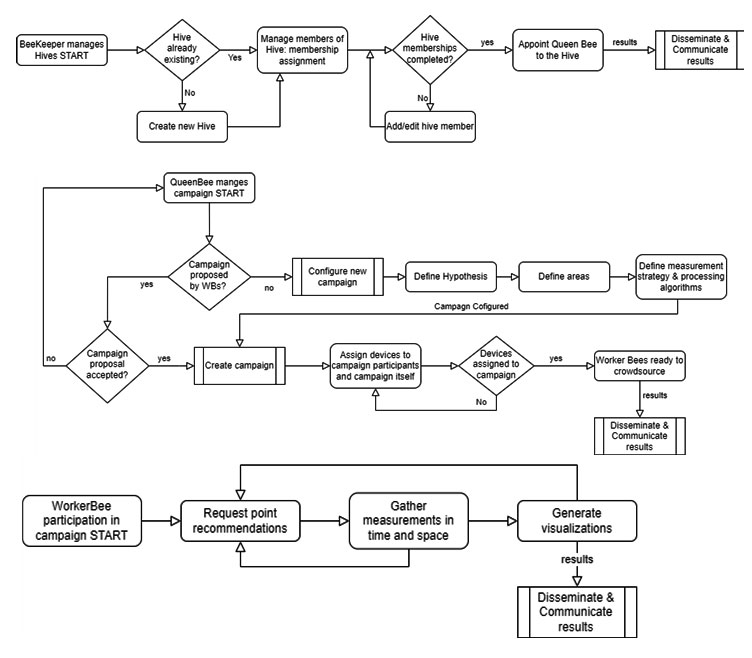
The diagrams in Figure 10 show the process that must be carried out within SOCIO-BEE to set-up a campaign in a pilot where air quality measurements will be gathered in a certain area and period to deliver visualizations and indicators summarizing the air quality situation and evolution in a spatial-temporal manner. Essentially, such diagram illustrates the different steps that must be carried out: a) configure a Hive by a Beekeeper, b) configure a campaign by a Queen Bee, and c) participate with crowdsourcing measurements in a campaign by Worker Bees.
Campaigns may be configured with different time slot lengths and the minimum number of measurements per time slot within the cells of predefined size configured within a provided geographical area. Thus, a campaign is configured based on how measurements wish to be done (measurement strategy defined in a campaign blueprint) and the number of participants taking part in the campaign. The goal is to be able to create data series of air quality in space and time dimensions in the most effective and effortless manner, from the Worker Bees point of view.
Thus, SOCIO-BEE’s Micro-Volunteering Engine’s (MVE) internal recommender system issues recommendations, at a given moment, according to available users and the air quality samples still required in time and space to cover the pollination objectives of a campaign. Every time a user requests measurement recommendations, the MVE provides a few cells that should be measured, i.e., in bees’ metaphor, to be pollinized. To set the priority of each cell, MVE first estimates the campaign needs following the default strategy that measurements should be spread evenly across all available time slots and a minimum number of measurements gathered per time slot.
4.3. Assessing of Citizen Science as instrument to mitigate air pollution
A similar approach to the one used in INTERLINK has been applied in SOCIO-BEE to assess the perceived adoption of its platform and approach as a catalyser of Citizen Science campaigns. In this case to tackle the issues associated to air quality in European cities. At the time of writing, we have not concluded yet the first pilots’ iteration across the 3 locations involved in the project, namely, Ancona (Italy) – which pushes elderly people to be active outdoors in a non-polluted and non-crowded environment, promoting a healthy lifestyle, Marousi (Greece) – which seeks the engagement of commuters and relevant stakeholders to actively contribute in understanding their individual exposure to air pollution, and Zaragoza (Spain), which aims to attract the younger public (8 to 16 years old) to this type of initiative so that they can take responsibility in caring for their air quality. As seen, the project aims to assess the effectiveness of SOCIO-BEE tools and approach to help different citizen collectives having a more active part and engagement in favour of air pollution mitigation.
The evaluation will be based again on the analysis of the platform’s usage logs and the evaluation questionnaires, completed by the participants, which have been designed to cover a wide range of measurement dimensions such as: a) air pollution reduction in the pilot sites; b) performance of the wearable air quality device provided; c) adoption rate of the SOCIO-BEE platform’s app and visualization tools; d) degree of inclusiveness of the Citizen Science participants and e) quantity and quality of the CS produced outcomes (datasets and analysis over them) and recommendations to enable decision making.
In parallel, we have also integrated INTERLINK and SOCIO-BEE to validate that INTERLINK’s CE can also be used in CS related co-production processes. During the piloting in SOCIO-BEE, we have realized that one of the biggest barriers for a more widespread adoption of CS practices is the complexity associated to handling the community and the work carried out by it, in the long run. Hence, a tool such as the CE supporting the community onboarding, guidance over the whole lifetime of a CS campaigns, acknowledging for collaborations, and tracking all its achievements (co-production resources) is very relevant. We hope to demonstrate that citizen science campaigns can be planned, executed, and exploited more effectively if a suitable collaborative environment is put in place. The validation of such hypothesis will be possible after analysing the data logs and answers to questionnaires completed during SOCIO-BEE’s pilots’ evaluation in iteration 1.
5. Conclusions and further work
Humanized computing is a computing paradigm which leverages on Large Techno Social Systems (LTSS) to engage users throughout the whole lifetime of a service realization, i.e. from design to delivery. We argue that co-production of public services and CS can help us progressing towards this new generation of computing that includes humans always in the loop, where information systems are built for and by the humans. For that, this paper has illustrated two examples of how to realize LTSS through co-production of public services and Citizen Science sociotechnical research domains. These examples have clearly showcased how technology and humans can be brought together to deliver more highly adopted common good services that allow us to tackle diverse societal challenges, e.g. air pollution or more widespread availability of inclusive and accessible e-government services for citizens. Importantly, in most of these domains, technology per se is not the solution, it is the proactive engagement and reciprocal cooperation of citizens with such technology. Indeed, we deem that reciprocal learning between machines and humans is a core catalyser for LTSS, providing its associated social and ethical aspects are also considered.
Further validations on how co-production of public services and Citizen Science can serve as core drivers of acceptance and then adoption of LTSS is needed. The two examples provided have showcased that humanized technology is a promising approach to empower citizens to actively engage in societal decision-making processes, participate in democratic systems, and contribute to societal welfare. However, the two studies undertook require of further exhaustive validation and impact assessment, to more accurately prove the value of these two approaches to realize Humanized Computing. Hence, future work will analyse how to operationalize Citizen Science campaigns, as the ones proposed in SOCIO-BEE, by the adoption of co-production support tools as the one created by INTERLINK. We plan to perform these evaluations within the execution of the second iteration of pilots in SOCIO-BEE and during the realization of the project GREENGAGE[35].
Acknowledgements
This work has been sponsored by projects INTERLINK – Innovating goverNment and ciTizen co-dEliveRy for the digitaL sINgle market, H2020 project with Grant ID 959201 and SOCIO-BEE – Wearables and droneS fOr CIty Socio-Environmental Observations and BEhavioral ChangE, H2020 project with Grant ID 101037648 and DEUSTEK5 (IT1582-22) Basque University system’s A grade research team grant.
6. References
Bonney, R., Cooper, C. B., Dickinson, J., Kelling, S., Phillips, T., Rosenberg, K. V., & Shirk, J. (2009). Citizen science: A developing tool for expanding science knowledge and scientific literacy. BioScience, 59(11), 977–984.
Bostrom, N., & Bostrom, N. (2016). Superintelligence: Paths, Dangers, Strategies. Oxford University Press.
Brandsen, T., Steen, T., & Verschuere, B. (Eds.). (2020). Co-Production and Co-Creation: Engaging Citizens in Public Services. Routledge.
Carayon, P. (2006). Human factors of complex sociotechnical systems. Applied Ergonomics, 37(4), 525–535.
Falco, E., & Kleinhans, R. (2019). Digital Participatory Platforms for Co-Production in Urban Development: A Systematic Review. In Crowdsourcing: Concepts, Methodologies, Tools, and Applications (pp. 663–690). IGI Global.
Floridi, L., Cowls, J., Beltrametti, M., Chatila, R., Chazerand, P., Dignum, V., Luetge, C., Madelin, R., Pagallo, U., Rossi, F., Schafer, B., Valcke, P., & Vayena, E. (2021). An Ethical Framework for a Good AI Society: Opportunities, Risks, Principles, and Recommendations. In L. Floridi (Ed.), Ethics, Governance, and Policies in Artificial Intelligence (pp. 19–39). Springer International Publishing.
Fritz, S., See, L., & Grey, F. (2022). The grand challenges facing environmental citizen science. Frontiers in Environmental Science, 10.
Front Page—Socio-bee.eu. (n.d.). Retrieved 11 September 2023.
Gil-Garcia, J. R., & Sayogo, D. S. (2016). Government inter-organizational information sharing initiatives: Understanding the main determinants of success. Government Information Quarterly, 33(3), 572–582.
GREENGAGE | GREENGAGE project. (n.d.). Retrieved 13 September 2023.
Home | Trello. (n.d.). Retrieved 14 March 2023.
Iannuzzi, I. (2019). Smart community: A new way of being together? In Smart Society. Routledge.
Interlink-project – Innovating goverNment and ciTizen co-dEliveRy for the digitaL sINgle marKet. (n.d.). Retrieved 10 March 2023.
Kazhamiakin, R., Marconi, A., Perillo, M., Pistore, M., Valetto, G., Piras, L., Avesani, F., & Perri, N. (2015). Using gamification to incentivize sustainable urban mobility. 2015 IEEE First International Smart Cities Conference (ISC2), 1–6.
López-De-Ipiña, D., Badiola, J., Silva, D. A., Casado-Mansilla, D., Not, E., Leonardi, C., Ortiz-de-Guinea, A., & Porto, I. (2022). A Collaborative Environment to Boost Co-Production of Sustainable Public Services. 2022 7th International Conference on Smart and Sustainable Technologies (SpliTech), 1–6.
Michie, S., Atkins, L., & West, R. (2014). The Behaviour Change Wheel: A Guide to Designing Interventions. Silverback Publishing.
Michie, S., van Stralen, M. M., & West, R. (2011). The behaviour change wheel: A new method for characterising and designing behaviour change interventions. Implementation Science, 6(1), 42.
Miro | Online Whiteboard for Visual Collaboration. (n.d.). Retrieved 14 March 2023.
Notion – One workspace. Every team. (n.d.). Notion. Retrieved 31 March 2022.
Puerta-Beldarrain, M., Gómez-Carmona, O., López-de-Ipiña, D., Casado-Mansilla, D., Barco, A., Jayo, U. H., & García-Zubia, J. (2023). A Micro-volunteering Engine to drive crowd-measuring of Air Quality in Citizen Science. 2023 8th International Conference on Smart and Sustainable Technologies (SpliTech), 1–6.
Rahwan, I. (2018). Society-in-the-loop: Programming the algorithmic social contract. Ethics and Information Technology, 20(1), 5–14.
Roman, M., Varga, H., Cvijanovic, V., & Reid, A. (2020). Quadruple Helix Models for Sustainable Regional Innovation: Engaging and Facilitating Civil Society Participation. Economies, 8(2), Article 2.
Services as Activities: Towards a Unified Definition for (Public) Services | IEEE Conference Publication | IEEE Xplore. (n.d.). Retrieved 13 November 2023.
Shiroishi, Y., Uchiyama, K., & Suzuki, N. (2019). Better Actions for Society 5.0: Using AI for Evidence-Based Policy Making That Keeps Humans in the Loop. Computer, 52(11), 73–78.
The Age of Surveillance Capitalism by Shoshana Zuboff | Hachette Book Group. (n.d.). Retrieved 13 November 2023.
The Second Machine Age. (n.d.). Retrieved 13 November 2023.
Van Brussel, S., & Huyse, H. (2019). Citizen science on speed? Realising the triple objective of scientific rigour, policy influence and deep citizen engagement in a large-scale citizen science project on ambient air quality in Antwerp. Journal of Environmental Planning and Management, 62(3), 534–551.
Voorberg, W. H., Bekkers, V. J. J. M., & Tummers, L. G. (2015). A Systematic Review of Co-Creation and Co-Production: Embarking on the social innovation journey. Public Management Review, 17(9), 1333–1357.
Weapons of Math Destruction by Cathy O’Neil: 9780553418835 | PenguinRandomHouse.com: Books. (n.d.). PenguinRandomhouse.Com. Retrieved 13 November 2023.
Weil, M., Reisch, M., & Ohmer, M. L. (2013). The handbook of community practice (2nd edition). SAGE Publications. http://www.credoreference.com/book/sagecompra
Wenger, E. (1998). Communities of practice: Learning, meaning, and identity (pp. xv, 318). Cambridge University Press.
Zagalsky, A., Te’eni, D., Yahav, I., Schwartz, D. G., Silverman, G., Cohen, D., Mann, Y., & Lewinsky, D. (2021). The Design of Reciprocal Learning Between Human and Artificial Intelligence. Proceedings of the ACM on Human-Computer Interaction, 5(CSCW2), 443:1-443:36.
[1] Carayon, P. (2006). Human factors of complex sociotechnical systems. Applied Ergonomics, 37(4), 525–535.
[2] Brandsen, T., Steen, T., & Verschuere, B. (Eds.). (2020). Co-Production and Co-Creation: Engaging Citizens in Public Services. Routledge.
[3] Bonney, R., Cooper, C. B., Dickinson, J., Kelling, S., Phillips, T., Rosenberg, K. V., & Shirk, J. (2009). Citizen science: A developing tool for expanding science knowledge and scientific literacy. BioScience, 59(11), 977–984.
[4] Voorberg, W. H., Bekkers, V. J. J. M., & Tummers, L. G. (2015). A Systematic Review of Co-Creation and Co-Production: Embarking on the social innovation journey. Public Management Review, 17(9), 1333–1357.
[5] Services as Activities: Towards a Unified Definition for (Public) Services | IEEE Conference Publication | IEEE Xplore. (n.d.). Retrieved 13 November 2023, from
[6] Wenger, E. (1998). Communities of practice: Learning, meaning, and identity (pp. xv, 318). Cambridge University Press.
[7] Weil, M., Reisch, M., & Ohmer, M. L. (2013). The handbook of community practice (2nd edition). SAGE Publications. http://www.credoreference.com/book/sagecompra
[8] Zagalsky, A., Te’eni, D., Yahav, I., Schwartz, D. G., Silverman, G., Cohen, D., Mann, Y., & Lewinsky, D. (2021). The Design of Reciprocal Learning Between Human and Artificial Intelligence. Proceedings of the ACM on Human-Computer Interaction, 5(CSCW2), 443:1-443:36.
[9] Rahwan, I. (2018). Society-in-the-loop: Programming the algorithmic social contract. Ethics and Information Technology, 20(1), 5–14.
[10] Iannuzzi, I. (2019). Smart community: A new way of being together? In Smart Society. Routledge.
[11] Michie, S., van Stralen, M. M., & West, R. (2011). The behaviour change wheel: A new method for characterising and designing behaviour change interventions. Implementation Science, 6(1), 42.
[12] Floridi, L., Cowls, J., Beltrametti, M., Chatila, R., Chazerand, P., Dignum, V., Luetge, C., Madelin, R., Pagallo, U., Rossi, F., Schafer, B., Valcke, P., & Vayena, E. (2021). An Ethical Framework for a Good AI Society: Opportunities, Risks, Principles, and Recommendations. In L. Floridi (Ed.), Ethics, Governance, and Policies in Artificial Intelligence (pp. 19–39). Springer International Publishing.
[13] Michie, S., van Stralen, M. M., & West, R. (2011). The behaviour change wheel: A new method for characterising and designing behaviour change interventions. Implementation Science, 6(1), 42.
[14] Weapons of Math Destruction by Cathy O’Neil: 9780553418835 | PenguinRandomHouse.com: Books. (n.d.). PenguinRandomhouse.Com. Retrieved 13 November 2023.
[15] The Age of Surveillance Capitalism by Shoshana Zuboff | Hachette Book Group. (n.d.). Retrieved 13 November 2023.
[16] The Second Machine Age. (n.d.). Retrieved 13 November 2023.
[17] Bostrom, N., & Bostrom, N. (2016). Superintelligence: Paths, Dangers, Strategies. Oxford University Press.
[18] Roman, M., Varga, H., Cvijanovic, V., & Reid, A. (2020). Quadruple Helix Models for Sustainable Regional Innovation: Engaging and Facilitating Civil Society Participation. Economies, 8(2), Article 2.
[19] López-De-Ipiña, D., Badiola, J., Silva, D. A., Casado-Mansilla, D., Not, E., Leonardi, C., Ortiz-de-Guinea, A., & Porto, I. (2022). A Collaborative Environment to Boost Co-Production of Sustainable Public Services. 2022 7th International Conference on Smart and Sustainable Technologies (SpliTech), 1–6.
[20] Falco, E., & Kleinhans, R. (2019). Digital Participatory Platforms for Co-Production in Urban Development: A Systematic Review. In Crowdsourcing: Concepts, Methodologies, Tools, and Applications (pp. 663–690). IGI Global.
[21] Gil-Garcia, J. R., & Sayogo, D. S. (2016). Government inter-organizational information sharing initiatives: Understanding the main determinants of success. Government Information Quarterly, 33(3), 572–582.
[22] Miro | Online Whiteboard for Visual Collaboration. (n.d.). Retrieved 14 March 2023, from
[25] Interlink-project – Innovating goverNment and ciTizen co-dEliveRy for the digitaL sINgle marKet. (n.d.). Retrieved 10 March 2023.
[26] López-De-Ipiña, D., Badiola, J., Silva, D. A., Casado-Mansilla, D., Not, E., Leonardi, C., Ortiz-de-Guinea, A., & Porto, I. (2022). A Collaborative Environment to Boost Co-Production of Sustainable Public Services. 2022 7th International Conference on Smart and Sustainable Technologies (SpliTech), 1–6.
[27] López-De-Ipiña, D., Badiola, J., Silva, D. A., Casado-Mansilla, D., Not, E., Leonardi, C., Ortiz-de-Guinea, A., & Porto, I. (2022). A Collaborative Environment to Boost Co-Production of Sustainable Public Services. 2022 7th International Conference on Smart and Sustainable Technologies (SpliTech), 1–6.
[28] Front Page—Socio-bee.eu. (n.d.). Retrieved 11 September 2023.
[29] Puerta-Beldarrain, M., Gómez-Carmona, O., López-de-Ipiña, D., Casado-Mansilla, D., Barco, A., Jayo, U. H., & García-Zubia, J. (2023). A Micro-volunteering Engine to drive crowd-measuring of Air Quality in Citizen Science. 2023 8th International Conference on Smart and Sustainable Technologies (SpliTech), 1–6.
[30] Kazhamiakin, R., Marconi, A., Perillo, M., Pistore, M., Valetto, G., Piras, L., Avesani, F., & Perri, N. (2015). Using gamification to incentivize sustainable urban mobility. 2015 IEEE First International Smart Cities Conference (ISC2), 1–6.
[31] Shiroishi, Y., Uchiyama, K., & Suzuki, N. (2019). Better Actions for Society 5.0: Using AI for Evidence-Based Policy Making That Keeps Humans in the Loop. Computer, 52(11), 73–78.
[32] Fritz, S., See, L., & Grey, F. (2022). The grand challenges facing environmental citizen science. Frontiers in Environmental Science, 10.
[33] Front Page—Socio-bee.eu. (n.d.). Retrieved 11 September 2023.
[34] Van Brussel, S., & Huyse, H. (2019). Citizen science on speed? Realising the triple objective of scientific rigour, policy influence and deep citizen engagement in a large-scale citizen science project on ambient air quality in Antwerp. Journal of Environmental Planning and Management, 62(3), 534–551.
PARTEKATU


